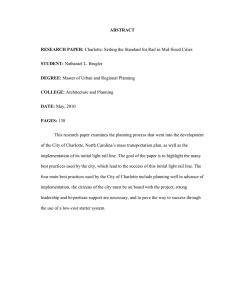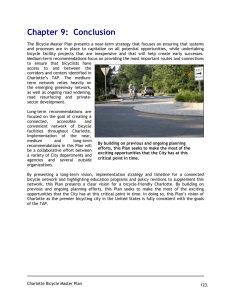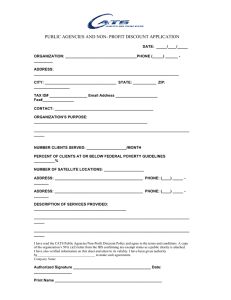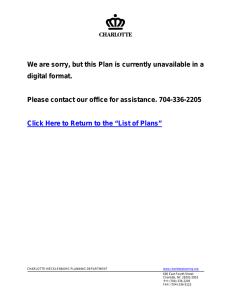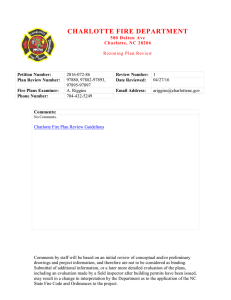Transportation & Planning Committee Thursday, January 26, 2012 1:30 – 3:00 p.m.
advertisement
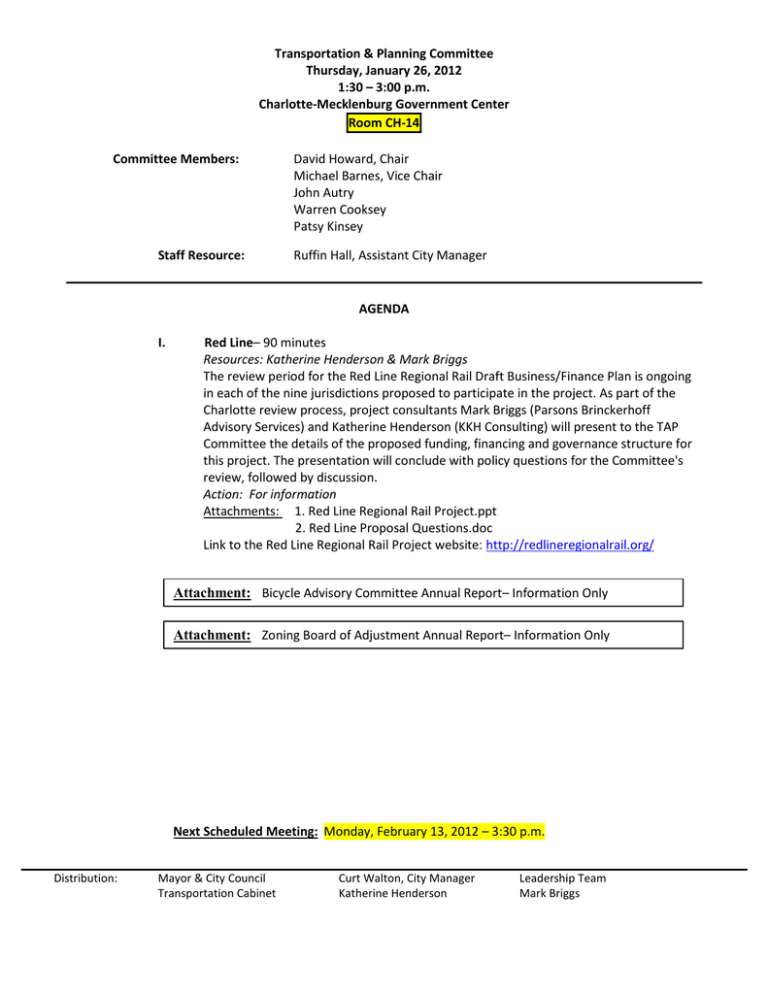
Transportation & Planning Committee Thursday, January 26, 2012 1:30 – 3:00 p.m. Charlotte-Mecklenburg Government Center Room CH-14 Committee Members: Staff Resource: David Howard, Chair Michael Barnes, Vice Chair John Autry Warren Cooksey Patsy Kinsey Ruffin Hall, Assistant City Manager AGENDA I. Red Line– 90 minutes Resources: Katherine Henderson & Mark Briggs The review period for the Red Line Regional Rail Draft Business/Finance Plan is ongoing in each of the nine jurisdictions proposed to participate in the project. As part of the Charlotte review process, project consultants Mark Briggs (Parsons Brinckerhoff Advisory Services) and Katherine Henderson (KKH Consulting) will present to the TAP Committee the details of the proposed funding, financing and governance structure for this project. The presentation will conclude with policy questions for the Committee's review, followed by discussion. Action: For information Attachments: 1. Red Line Regional Rail Project.ppt 2. Red Line Proposal Questions.doc Link to the Red Line Regional Rail Project website: http://redlineregionalrail.org/ Attachment: Bicycle Advisory Committee Annual Report– Information Only Attachment: Zoning Board of Adjustment Annual Report– Information Only Next Scheduled Meeting: Monday, February 13, 2012 – 3:30 p.m. Distribution: Mayor & City Council Transportation Cabinet Curt Walton, City Manager Katherine Henderson Leadership Team Mark Briggs Red Line Regional Rail Overview Presentation 12/13 Red Line Task Force Summit Mooresville, NC Red Line Regional Rail Project North Corridor: Mooresville to Charlotte Funding, Financing and Governance Funding Financing and Governance Charlotte Transportation and Planning Committee Charlotte, NC January 26, 2012 Mark Briggs, Parsons Brinckerhoff Katherine Henderson, KKH Consulting Slide 1 Red Line Regional Rail Unified Benefit District (UBD) District (UBD) Slide 2 Red Line Regional Rail Overview Presentation 12/13 Red Line Task Force Summit Mooresville, NC PRESENTATION OUTLINE • • • • Governance: Joint Powers Authority Governance: Joint Powers Authority Funding and Finance Plan Recommendations Process/Next Steps Slide 3 GOVERNANCE: JOINT POWERS AUTHORITY Slide 4 Red Line Regional Rail Overview Presentation 12/13 Red Line Task Force Summit Mooresville, NC Joint Powers Authority Recommendations • Limited‐power regional entity formed for the single purpose of executing for the single purpose of executing the Red Line Regional Rail (Phases I and II) • Created by mutual consent of the seven North Corridor local governments • Closely related to and controlled by Closely related to and controlled by its member agencies, including CATS and the State, through Board representation Slide 5 North Carolina JPA Enabling Legislation 160A‐462. Joint agencies. (a) Units agreeing to an undertaking may establish a joint agency charged with any or all of the responsibility for the undertaking. The units may confer on the joint agency any power, duty, right, or function needed for the execution of the undertaking, except that legal title to all real property necessary to the undertaking shall be held by the participating units individually, or jointly as tenants in common, in such manner and proportion as they may determine. determine. (b) The participating units may appropriate funds to the joint agency on the basis of an annual budget recommended by the agency and submitted to the governing board of each unit for approval. Slide 6 Red Line Regional Rail Overview Presentation 12/13 Red Line Task Force Summit Mooresville, NC North Carolina Revenue Bond Act Article 5 of Chapter 159; 159‐80 and following: • Permits revenue bonds to be issued for a public transportation system and for economic development for economic development • Specifically authorizes the use of the Revenue Bond Act by Joint Agencies by defining the term “Municipality” to include joint agencies under Article 20 of Chapter 160A • Revenues that JPA can pledge toward revenue bond include : – TIF – Special Assessment District – Revenues from a contract with the State Express statutory authorization in North Carolina for issuance of revenue bonds by a joint agency as envisioned for Red Line Slide 7 Creating a JPA: Project Recommendations 3) If a joint agency is established, its composition, organization, and nature, together with the powers conferred on it; Proposed JPA powers: – Ability to receive revenues – Ability to issue bonds (based on revenues from members) – Ability to allocate/spend money within the UBD on approved expenditures – Ability to own assets, except real property – Ability to enter into contracts – Ability to sue (or be sued) JPA WOULD NOT BE GRANTED THE POWER TO TAX § 160A‐464. Provisions of the agreement Slide 8 Red Line Regional Rail Overview Presentation 12/13 Red Line Task Force Summit Mooresville, NC Creating a JPA: Project Recommendations 3) If a joint agency is established, its composition, organization, and nature, together with the powers conferred on it; f d i Structure of 18‐member Board: • • • • • • • • • State of NC: two members CATS: two members City of Charlotte (non‐CATS): two members Town of Huntersville: two members T Town of Cornelius: two members fC li t b Town of Davidson: two members Town of Mooresville: two members Mecklenburg County: two members Iredell County: two members § 160A‐464. Provisions of the agreement Slide 9 Creating a JPA: Project Recommendations JPA Function Strategic Planning, Policies & Operating Guidelines Administration / Governance; Legal and Intergovernmental Affairs Financial Management, including Budgets and Annual Reports Operations & Maintenance Type Internal Board Personnel / Notes Internal Executive Director Internal Planning for both Phase I and II Contract Project Development / Execution; Design & Construction Management Communications / Public Relations Legal / Bond Finance / P3 Procurement Contract Finance Director. Must also appoint treasurer and auditor. Member jurisdiction or third party. Ongoing, long-term. Member jurisdiction or third party. Some ongoing functions, some discrete projects. projects Third party, discrete projects Contract Contract Third party, as-needed Third party. Heaviest at JPA inception. § 160A‐464. Provisions of the agreement Contract Slide 10 Red Line Regional Rail Overview Presentation 12/13 Red Line Task Force Summit Mooresville, NC Creating a JPA: Project Recommendations 9) Any other necessary or proper matter. • JPA agreement explicitly protects all member JPA agreement explicitly protects all member jurisdictions from recourse • Local control of local rail‐related infrastructure improvements, following: – – – – – Adopted Station Area Plan Cost analysis vs JPA execution Design and construction specs Design and construction specs Bid documents and solicitation Contractor selection § 160A‐464. Provisions of the agreement Slide 11 State Leadership and Support • Project leadership role by NCDOT and consultants – Scoping, planning, review and adoption processes Scoping planning review and adoption processes • Strategic position and transportation experience – NCDOT rail knowledge and expertise • History of State backing for infrastructure borrowing • State will review plan, potentially commit to: – Fund 25 percent of the project capital construction costs Fund 25 percent of the project capital construction costs – Fund 25 percent of ongoing O&M costs – Back the bond financing package Slide 12 Red Line Regional Rail Overview Presentation 12/13 Red Line Task Force Summit Mooresville, NC FUNDING AND FINANCING PLAN Slide 13 Project Costs (2018 dollars) Project Component Main Line Track Grade Crossings Vehicles Stations Charlotte Terminal Area & Vehicle Inspection Facility Systems Professional Services NS Licensing Agreement Freight Rail Rationalization Project Reserve Station Area Improvements Total Source: CATS Slide 14 Estimated Cost (millions) $70.5 $44 9 $44.9 $58.3 $56.6 $66.0 $25.8 $40.9 $28.1 $5.7 $11.6 $43.6 $452.0 Red Line Regional Rail Overview Presentation 12/13 Red Line Task Force Summit Mooresville, NC RLRR Finance Plan: Funding Partnership Total project capital cost: $452M Capital and O&M proposed to be funded via p p p the following partnership: • 25% CATS = $113 M (transit funds) • 25% State = $113 M (multimodal funds) • 50% Local = $226 M (value capture) Slide 15 Unified Revenue Approach • The TIF and Assessment District revenues are “rolled revenues are rolled up up” into the into the cumulative amounts • The revenues are allocated by contract from the jurisdictions to the Joint Powers Authority (JPA) • JPA will offer “Availability Payments” based on the combined TIF and Assessment District revenues • The JPA secures the financing through the issuance of bonds or P3 approach Slide 16 Red Line Regional Rail Overview Presentation 12/13 Red Line Task Force Summit Mooresville, NC TIF and SAD: Who is Affected? • Both mechanisms affect ONLY those properties in the Unified Benefit District. The rest of the properties in each town, city Benefit District. The rest of the properties in each town, city or county are not affected. • Within the project’s Unified Benefit District, – Tax‐Increment Financing: • Is allocated by municipalities and counties • Does not affect property owners – Special Assessment District: Special Assessment District • Is self‐imposed by majority petition • Affects only income‐producing properties Slide 17 Value Capture Development Assumptions • Projected “Value Capture” only includes known projects • Identified projects: Identified projects: – Beginning construction with projected phasing – Where owners commit to develop as the economy improves – On key sites where jurisdictions are confident that near‐term development will occur – With development plans endorsed by jurisdictions (densities, mix of uses and entitlements) Slide 18 Red Line Regional Rail Overview Presentation 12/13 Red Line Task Force Summit Mooresville, NC Key Project: Gandy Communities Phil Gandy: Phil G d “I began to assemble the properties six years ago because I saw the vision for a TOD and thought it was worth the investment. The design of the project and the uses all focus on project and the uses all focus on the coming of the Red Line.” Slide 19 Key Project: Gandy Communities • Area A: – 18 acres open space – 150 K retail – 300 K office – 800 residential units • Area B: – 8 acres open space – 120 residential units – 150 K office • Area C: – 11 acres open space – 120 K office and retail – 750 residential units • Area D: – 5 acres open space 5 – 350 residential units Build out value: $220.8 M Slide 20 Red Line Regional Rail Overview Presentation 12/13 Red Line Task Force Summit Mooresville, NC Financing Options: Bond Approach • The importance of full participation in the Assessment District • Provides early year revenues before the Tax increment Revenues are realized yy RLRR Annual Tax Increment Revenues ANNUAL SNAPSHOT RANGE 2016 2021 2026 2031 2036 High $ 7,457,011 $ 21,609,741 $ 27,586,137 $ 29,769,517 $ 30,632,619 Medium $ 7,239,816 $ 20,980,331 $ 26,782,657 $ 28,902,443 $ 29,740,407 Low $ 7,022,622 $ 20,350,921 $ 25,979,177 $ 28,035,370 $ 28,848,195 RLRR Annual Special Assessment Revenues ANNUAL SNAPSHOT RANGE 2016 2021 2026 2031 2036 High $ 16,283,498 $ 25,156,079 $ 29,305,518 $ 30,819,182 $ 31,749,826 Medium $ 15,809,221 $ 24,423,377 $ 28,451,959 $ 29,921,536 $ 30,825,074 Low $ 15,334,944 $ 23,690,676 $ 27,598,400 $ 29,023,890 $ 29,900,322 Slide 21 Independent National Bond Underwriters: Proposed Structures • Stone Stone & Youngberg proposes a structure utilizing & Youngberg proposes a structure utili ing the tax increment and assessment revenues as a single source for bond payments • Guggenheim Securities proposes separate bond issues with early assessment bonds and later tax increment bonds • Both approaches are viable Both approaches are viable Slide 22 Red Line Regional Rail Overview Presentation 12/13 Red Line Task Force Summit Mooresville, NC Stone & Youngberg Structure • CATS Share: Funding through Zero Coupon Revenue Anticipation Notes (RANs) repaid in 2018 at 3% interest rate • State Share: Funding through Revenue Anticipation Notes (RANs) repaid quarterly from 2014 through 2018 at interest rate ranging from 1.2% to 2.3%. • Local Share: y ( – 30‐year Revenue Bonds (based on tax increment and assessment district revenues) at 4% to 5% interest rates – Includes $11 million in capitalized interest, a $19 million reserve fund, and no less than a 1.4 annual coverage – Cumulative retained revenues exceed $1 billion, before use for O&M costs Slide 23 Stone & Youngberg Summary JPA SA/TIF CATS NCDOT SA/TIF Revenues Total Construction Bond Proceeds RAN Proceeds RAN Proceeds Applied to Const. Proceeds 2013 $ 32,958,331 $ 14,288,963 $ 15,753,997 $ 11,131,292 $ 74,132,583 2014 $ 56,499,996 $ 24,495,366 $ 27,006,852 $ 8,859,837 $ 116,862,051 2015 $ 56,499,996 $ 24,495,366 $ 27,006,852 $ 108,002,214 2016 $ 56,499,996 $ 24,495,366 $ 27,006,852 $ 108,002,214 2017 $ 23,541,681 $ 10,206,402 $ 11,252,855 $ 45,000,938 $ 97,981,463 $ 108,027,408 $ 19,991,129 $ 452,000,000 Total $ 226,000,000 Slide 24 Red Line Regional Rail Overview Presentation 12/13 Red Line Task Force Summit Mooresville, NC Guggenheim Securities Approach • NC DOT pays 25% – Not financed: funding received evenly g y • CATS pays 25% – Lump sum after construction – Financed with a short‐term, stand‐alone note • Assessment bonds will be 25% – Sold upfront – Bond sizing will be limited to an amount that can be supported (with coverage) from assessments available on the date of bond sale • TIF bonds will pay for 25%. – Sold last – Will still need credit enhancement for a period of time Slide 25 Summary of Guggenheim Securities Program Revenue Source Timing Credit Quality Conclusion NC DOT During Construction AAA Use as PAYGO CATS After Construction A Category Stand‐alone RAN’s Assessment Immediately available Non Rated , but very attractive to market k t Non Rated Assessment Bonds Tax Increment Available only after No revenues, new construction unsellable Slide 26 JPA BAN’s, backstopped by State of NC, offset by TIF, refinanced ASAP Red Line Regional Rail Overview Presentation 12/13 Red Line Task Force Summit Mooresville, NC Excess Revenues • Under either approach, there will be excess revenues beyond debt service and O&M costs debt service and O&M costs • At a pre‐established threshold, the JPA will evaluate: – Reducing the 75/25 split of the tax increment revenues – Reducing the special assessment level from .75/$100 of assessed values Slide 27 Financing Options: P3 Approach Assumptions – DBFOM Scenario • Capital cost of $452M • CATS and NCDOT each contribute $113M towards capital (interest and principal) through issuance of $206M revenue anticipation notes (RANs) – 5 years @ 1.9 to 3.3% • Special Assessment and Tax Increment Financing (SA/TIF) revenues PAYGO during construction ($87M) • Balance of construction costs financed by private partner Balance of construction costs financed by private partner – – – – Debt/Equity: 80/20 Debt: Private Activity Bonds (PABs) @ 6.0% Equity: 10.0% return required Term: 30 years (2013 – 2043) Slide 28 Red Line Regional Rail Overview Presentation 12/13 Red Line Task Force Summit Mooresville, NC Sources of Funds – DBFOM Scenario NCDOT RAN Proceeds $108M, 24% PABs $127M, 28% CATS RAN Proceeds $98 M , 22% P3 Partner, 35% Equity $32 M , 7% TIF/SA Applied to Construction PAYGO $87M , 19% Slide 29 Sponsor Cash Flows – DBFOM Scenario $100 $80 2.5x 2.5x 2.0x Slide 30 2042 2040 2038 2036 2034 2032 2030 2028 2026 0.0x 2024 $0 2022 0.5x 2020 $20 2018 1.0x 2016 $40 2014 1.5x 2012 $60 2010 Nominaal Dollars (Million) 3.0x State of NC RAN Bond Proceeds CATS RAN Bond Proceeds SA/TIFRevenue PAYGO during Construction Fare Revenues Fare Revenues Incremental FTA Formula Funds (Approx.) SA/TIF Revenue After PAYGO Availability Payments AP Coverage Avvailability Payment Coverage $120 Red Line Regional Rail Overview Presentation 12/13 Red Line Task Force Summit Mooresville, NC Assumptions – DBOM Scenario • Capital cost of $452M • CATS and NCDOT each contribute $113M towards capital CATS and NCDOT each contribute $113M towards capital (interest and principal) through issuance of $206M revenue anticipation notes (RANs) – 5 years @ 1.9 to 3.3% • SA/TIF Revenues PAYGO to construction $20M • SA/TIF Revenue Bond Proceeds $226M with State backstop – 4.00% to 5.00% annual coupon 4 00% 5 00% l – 30 year term from date of issuance (6/1/2013) Slide 31 Sources of Funds – DBOM Scenario SA/TIF PAYGO During Construction $20 M , 4% NCDOT RAN Proceeds $108 M , 24% SA/TIF Bond Proceeds $226 M , 50% CATS RAN Proceeds $98 M , 22% Slide 32 Red Line Regional Rail Overview Presentation 12/13 Red Line Task Force Summit Mooresville, NC Sponsor Debt Service – DBOM Scenario 5.0x Annual Debt Service on SA/TIF Bonds 4.5x SA/TIF Revenues Applied to Bonds Nom minal Dollars (Million) $100 $ Coverage (SA&TIF Revenue/Debt Service ) Coverage (SA&TIF Revenue/Debt Service ) 4.0x 3.5x $80 3.0x $60 2.5x 2.0x $40 1.5x Debt Service Coveerage Ratio D $120 1.0x $20 0.5x 2042 2040 2038 2036 2034 2032 2030 2028 2026 2024 2022 2020 2018 2016 2014 2012 0.0x 2010 $0 Slide 33 Sponsor’s Operating Cash Flows – DBOM Scenario 5.0x Annual Debt Service on SA/TIF Bonds 4.5x Operating and Maintenance Costs $100 Mid Life Overhaul Mid‐Life Overhaul 4.0x Total Revenue 3.0x $60 2.5x 2.0x $40 1.5x 1.0x $20 0.5x Slide 34 2042 2040 2038 2036 2034 2032 2030 2028 2026 2024 2022 2020 2018 2016 2014 0.0x 2012 $0 2010 Nominal Dollars (Million) 3.5x Total Revenue/Total Cost $80 Ratio of TTotal Revenue to Total Costs $120 Red Line Regional Rail Overview Presentation 12/13 Red Line Task Force Summit Mooresville, NC Several Tiers of Downside Protection • Proposal projections are very conservative: – Only Only “known” known projects used in revenue projections: projects used in revenue projections: $4.9 billion of development vs. $6.9 in Noell study – No escalation factor on property values • Bond underwriters further discount model assumptions • Bond underwriters require: – Project to generate and maintain cash reserves for lean years – Project to generate extra revenues each year above what is needed to Project to generate extra revenues each year above what is needed to pay debt service (high coverage ratios) • If all else fails: – State provides cash backstop during lean years (will be repaid) Slide 35 Conclusions for P3 Options • Both DBFOM and DBOM scenarios appear financially feasible • Both scenarios require a State backstop Both scenarios require a State backstop • Anticipated revenues in the public finance scenario cover debt service and O&M and achieve high coverage • DBFOM would bear a higher cost of capital but could lead to higher efficiencies through higher risk transfers – No cost/schedule efficiencies or risk transfers were assumed • A comprehensive business case should also be developed to assess A comprehensive business case should also be developed to assess the tradeoffs between DBOM and DBFOM Slide 36 Red Line Regional Rail Overview Presentation 12/13 Red Line Task Force Summit Mooresville, NC RECOMMENDATIONS Slide 37 Create a Joint Powers Authority (JPA) • Each of the seven North Corridor jurisdictions should: – Approve the creation of a Joint Powers Authority with Approve the creation of a Joint Powers Authority with powers, limitations and representation established by the participants – Appoint two members to the JPA Board and authorize two members each from NCDOT and CATS Slide 38 Red Line Regional Rail Overview Presentation 12/13 Red Line Task Force Summit Mooresville, NC Initiate the Tax Increment Financing (TIF) • All seven North Corridor jurisdictions should: – Adopt Adopt the Tax Increment Financing District boundaries the Tax Increment Financing District boundaries – Instruct the County Tax Collector to allocate 75 percent of the incremental property taxes from the parcels within those boundaries to the JPA to fund the Red Line • The City of Charlotte should: – Allocate 75 percent of the incremental property taxes from Gateway Station parcels in three equal amounts • One‐third to the JPA • One‐third to the future commuter line to Gastonia • One‐third to the future commuter line east to Monroe Slide 39 Approve Special Assessment District • The four towns and City of Charlotte should: – Secure Secure requisite percentages of signatures from income requisite percentages of signatures from income‐ producing properties to adopt the Assessment District – Establish the special assessment rate at .75/$100 of assessed values in the District – Allocate 100 percent of the assessment revenues to the JPA to fund the Red Line Note: For Gateway Station, where existing Municipal Service District (MSD) levies are in place, set the assessment equal to the amount to bring the total assessment to .75/$100 of assessed values. 100 percent of this incremental assessment will be allocated to the JPA. Slide 40 Red Line Regional Rail Overview Presentation 12/13 Red Line Task Force Summit Mooresville, NC Pursue Joint Developments and Negotiated Agreements – Each jurisdiction owning land that is planned for new private development should: private development should: • Develop the criteria for the new development • Plan for the solicitation of development partners as the market warrants – Each jurisdiction should: • Prepare or revise their Station Area Plans to incorporate land owned by the jurisdiction • Enter into negotiations with land owners for the station development where appropriate Slide 41 Fund Operation and Maintenance Costs • The JPA should: – All Allocate the annual Revenue Available Payments in excess t th lR A il bl P t i of the annual bond debt service for the local share for operations and maintenance (O&M) costs Slide 42 Red Line Regional Rail Overview Presentation 12/13 Red Line Task Force Summit Mooresville, NC Implement the Financing Approach To implement the financing approach, the JPA should: – Select underwriters to structure the bond financing Select underwriters to structure the bond financing • Revenue Anticipation Notes (RANs) to fund CATS and State portion • 30‐year Revenue Bonds (RA Payments as the “first call”) – Select P3 approach and solicit bids under either a DBOM or DBFOM scenario, to include: • • • • Final design Selection of rolling stock and technical programs Selection of rolling stock and technical programs Construction Operations and maintenance Slide 43 PROCESS AND NEXT STEPS Slide 44 Red Line Regional Rail Overview Presentation 12/13 Red Line Task Force Summit Mooresville, NC Ongoing Five‐Phase Process Phase I: 2010 RLTF Formed; Project Redefined Phase II: 2011 Develop Draft Business / Finance Plan Phase III: 2012 1) Review and Adoptions 2) Establishment of JPA & Funding / Financing Mechanisms Phase IV: 2013 1) Activation of JPA & Funding / Financing Mechanisms 2) Financing/Bond Sales & P3 Negotiations Phase V: 2014-2016 Project Construction 2017: Service Begins Phase III Began with Plan Referral Slide 45 Draft Business/Finance Plan: Take‐Aways 1. Local governments can participate in the project while maintaining control and protecting individual property rights. maintaining control and protecting individual property rights. 2. Towns and counties are protected from financial recourse. 3. The project can be fully funded now, including capital costs and operations and maintenance costs for 30 years. 4. The project is financially sound, and represents an attractive investment to the financial community. 5. All aspects of the proposed approach to fund and implement the project are currently allowed by state law. Slide 46 City of Charlotte - Transportation and Planning Committee January 26, 2012 Red Line Proposal Review Questions Financial feasibility 1. Are the growth and development assumptions reasonable in the current economic climate? 2. How is the Tax Increment Financing and Special Assessment revenue proposal structured? Are the revenue growth assumptions reasonable? 3. Are the assumptions on operating and capital costs consistent with CATS projections? 4. How does the financing plan interact and/or depend on City of Charlotte debt? 5. What is the impact of the proposed Red Line financing plan on CATS financial projections? 6. How is the “backstop” for risk handled by the Joint Powers Authority and/or the State of N.C.? Policy / Planning impacts 7. Are there any impacts to adopted Council policy? i. Tax Increment Financing cap? ii. Land use planning? iii. Current economic development initiatives? iv. Other? Partnerships / Regulatory Environment 8. How do the various proposed partnerships interact with the Red Line proposal and the City of Charlotte? a. Mecklenburg and Iredell Counties? b. Towns? c. State of North Carolina? d. Norfolk Southern Rail? 9. How does the proposed Joint Powers Authority interact with the Metropolitan Transit Commission (MTC) from governance, legal and policy perspectives? 10. What is the process for establishing station area development standards? 11. What is the impact of the proposal on the Charlotte Gateway Station? MEMORANDUM FROM THE OFFICE OF THE CITY CLERK DATE: TO: FROM: SUBJECT: January 9, 2012 Transportation and Planning Committee Members Stephanie C. Kelly, CMC, City Clerk Bicycle Advisory Committee Annual Report The attached report of the Bicycle Advisory Committee is being sent to you pursuant to the Resolution related to Boards and Commissions adopted by City Council at the November 23, 2009 meeting. This resolution requires annual reports from City Council Boards and Commissions to be distributed by the City Clerk to both City Council and to the appropriate Committee for review. If you have questions or comments for these committees, please convey those to staff support for a response and/or follow-up. Bicycle Advisory Committee December 2011 To: Mayor and City Council From: Bicycle Advisory Committee Subject: Report of Committee Activity for Calendar Year 2011 As required by the Charlotte City Council’s current policy for boards and commissions, the Bicycle Advisory Committee (BAC) is submitting this report of committee activity for the period of January 2011 through December 2011. The BAC serves in an advisory capacity. This includes: • Making recommendations to the City Council and County Commission on policies and issues related to bicycle transportation. • Seeking the implementation of bicycle-related transportation plans and policies within the jurisdiction of the City of Charlotte or Mecklenburg County. • Participating in the development and update of those plans and policies. • Making recommendations on actions that are appropriate and necessary to improve the efficiency and safety of bicycle transportation. • Discussing and advocating issues and opportunities to create a more bicycle-friendly Charlotte. The BAC is composed of eleven (11) members. Six (6) of these members are appointed by the Charlotte City Council, three (3) by the Mayor of Charlotte and two (2) by the Mecklenburg County Commissioners. Committee members serve without compensation. The 2011 BAC members were: Dick Winters, Chair Jane Cacchione, Vice Chair Hal Bouton Eric Banks Frank Burns Ann Gabrielson Jonathan Harding Scott Kusel D.C. Lucchesi Andrew Pike Jane Wasilewski All members have attended meetings in CY 2011. The term of one member will expire in December 2011 and he has requested not to be reappointed due to his residential relocation. Another member will not meet the required annual attendance and will be ineligible to remain on the committee following this calendar year. Regularly scheduled meetings of the committee are held at 6:00pm on the fourth Tuesday of the month at the Charlotte-Mecklenburg Government Center. During calendar year 2011, the BAC members regularly met and addressed such agenda items that included, but were not limited to, the following: • • • • • • • • • • • • Discussed the issue of sunken drainage grates during the resurfacing process in an effort to identify any recommendations to lessen their risk to cyclists. Received a report on the implementation process of the adopted Urban Street Design Guidelines. Participated in and monitored the development of the North East Corridor Infrastructure action plan for implementing bicycle facilities in the corridor. Recommended the installation of test bicycle detection devices at four problematic signalized intersections, with a goal of decreasing red light violations by cyclists uncertain if their bicycle was able to trigger a signal change. Recommended criteria and locations for future installations. Monitored the development and made recommendation for the adoption of the update of the City Transportation Action Plan. Developed the theme for the 2011 BIKE!Charlotte series of cycling events intended to raise awareness of bicycle transportation and safety. Among the events was a BAC led ride open to the public primarily along one of the City’s signed bicycle routes. BAC members participated in the annual Mayor’s Ride to Breakfast as the kickoff event of BIKE!Charlotte. Monitored the annual collection of data of bicycle boardings on transit buses. Monitored the progress of additions to the Mecklenburg County greenway system. Participated and monitored the development of the Beal Street bicycle pathway alternative to Wendover Road. The BAC Silver subcommittee met six times during CY2011. This subcommittee was appointed by the BAC and is composed of five BAC members. It is charged with review of the City’s bicycle transportation progress since receiving a bronze Bicycle Friendly Community Award from the League of American Bicyclists in 2008, with a goal of offering the best opportunity to achieve a Silver rating with the next BFC review in 2012. Received a report on the analysis of bicycle crash statistics. Received a presentation regarding bicycle share programs to aid in determining its potential in Charlotte. • • • • • • • • • • • • • • • • • • • • Reviewed the Bike Smart in Charlotte bicycle safety brochure. Reviewed the development of a Spanish language version of the bicycle safety brochure and video. Reviewed planning for the construction of a bicycle passage across the median of South Blvd connecting Carson Street and Lexington Street in an effort to improve connectivity for bicycling. Continued monitoring street resurfacing projects and restriping to ensure creation of bicycle facilities when practical. Development of the second edition of the Charlotte Cycling Guide. The guide includes a map of all bicycle lanes, signed bicycle routes and greenways in the city and includes recommended routes and safety information. Updated the Bicycle Advisory Committee Rules of Procedure to reflect references to bicycle planning documents adopted since the original bicycle plan. Reviewed plans for a preferred greenway crossing under the planned final section of I485 by the Clarks Creek and future greenway. Reviewed and made recommendations for bicycle facilities in the East Boulevard conversion project. Reviewed the routing plan for the signed Bicycle Route 15. Monitored the development of the NCDOT street design guidelines as they apply to bicycle facilities. Investigated Cycle Tracks as a potential bicycle facility in some Charlotte urban situations. Reviewed and offered support for the TIGER 3 grant to develop a continuous bicycle facility from Uptown Charlotte to the Cabarrus County line, and potentially to the Town of Davidson. Monitored potential traffic calming project for Scaleybark Road. Received reports on the progress of the bicycle parking project conducted jointly with the Charlotte Area Bicycle Alliance (CABA). Some BAC members participated in leading tours of bicycle facilities during BIKE!Charlotte, the Conferences of the North Carolina Chapter of the American Planning Association and the professional development seminars of the Association of Pedestrian and Bicycle Professionals. Monitored the successful implementation of the bicycle passage in the Dion Street barricade, which provided much needed connectivity for bicycles. Monitored the bicycle friendly improvements to the bicycle bridge crossings of Little Sugar Creek Greenway. Initiated planning for 2012 BIKE!Charlotte series of events to raise bicycle awareness. Offered bicycle related webinars as education tools for engineering and planning staff. Developed criteria for the installation of Shared Lane Arrows in Charlotte. • • • • Investigating the experimental use of green colored bicycle lanes in Charlotte to raise both motorists’ and cyclists’ awareness of those as safety facilities. Monitoring the development of NCDOT’s project to widen Graham Street which is to include bicycle lanes. Review of bicycle lane projects including South Tryon Street, Clanton Road, Rea Road, Tom Hunter Road, Community House Road, and East Boulevard, among others. Support for the county greenway program, including participation in greenway openings, the annual joint tour with the Greenway Advisory Committee and support for grants to be used for greenway development. The BAC also wishes to express its appreciation to City Council for its continued support of projects and policies furthering bicycle transportation, safety of cyclists and creating a more bicycle friendly Charlotte. MEMORANDUM FROM THE OFFICE OF THE CITY CLERK DATE: TO: FROM: SUBJECT: January 20, 2012 Transportation and Planning Committee Members Stephanie C. Kelly, CMC, City Clerk Zoning Board of Adjustment Annual Report The attached report of the Zoning Board of Adjustment is being sent to you pursuant to the Resolution related to Boards and Commissions adopted by City Council at the November 23, 2009 meeting. This resolution requires annual reports from City Council Boards and Commissions to be distributed by the City Clerk to both City Council and to the appropriate Committee for review. If you have questions or comments for this board, please convey those to staff support for a response and/or follow-up. • «D) CHARWTTE DATE: January 17, 2012 TO: Mayor a~.i ity coun. cil • \i~ du1s:aif FROM: Jeffrey Zoning Board of Adjustment SUBJECT: Annual Report of the Zoning Board of Adjustment As required by the Charlotte City Charter and City Council's current policy for Boards and Commissions, the Zoning Board of Adjustment (ZBA) is hereby submitting a report of its activities for the calendar year 2011. The Zoning Board of Adjustment shall have the following powers and duties to be carried out in accordance with these regulations which include, but are not limited to, the following: 1. 2. 3. 4. 5. 6. To hear and decide appeals from and to review any specific order, requirement, decision, or determination made under these regulations by the Zoning Administrator. To hear and decide petitions for variances from these regulations in accordance with the provisions of Section 5.108. To adopt such rules of procedure necessary for the administration of its responsibilities not inconsistent with these regulations. To assume any other duties assigned by the City Council. The Board of Adjustment shall not have jurisdiction with respect to Section 6.201 Conditional Districts except as provided in this section. The Board of Adjustment shall not have authority to grant variances for use changes. The Board's regular scheduled meetings are held the last Tuesday of each month at 9:00 a.m. at the Charlotte Mecklenburg Government Center. Additional meetings and hearings are scheduled as needed. The Planning Department Zoning Administration Division serves as support to the Board. The City's Legal Department also provides assistance. The Board met in excess of 80 hours for variance and appeal hearings which included eleven (11) regular meetings. Board members prepare for meetings/hearings by reviewing applications, staff recommendations, and hearing documents. Total Cases for 2011: 29 MONTH January February March April CHARLOTTE-MECKLENBURG # CASES 2 2 3 5 PLANNING MONTH May June July August DEPARTMENT #CASES 0 3 2 1 MONTH September October November December #CASES 2 4 0 5 www.charlotteplanning.org 600 East Fourth Street Charlotte, NC 28202-2853 PH: (704)-336-2205 FAX: (704)-336-5123 2011 ZBA Annual Report Page 2 of2 The Zoning Board of Adjustment has eight (8) members (5 regular members and 3 alternates). City Council appoints three (3) regular members, the County appoints one (1) regular member and the Mayor appoints one (l) regular member. City Council appoints two (2) alternates and the Mayor appoints one (1) alternate. Members are appointed for a term of three (3) years and until their respective successors have been appointed and qualified. No member shall serve more than two (2) full consecutive terms. Alternate members serve on the Board in the absence of any regular member and are appointed in the same manner and for the same term as regular members. All members are required to attend at least 65% of the regular and special meetings held in any calendar year with no excused absences. In order to be eligible for reappointment, the member must have attended at least 75% of the regular scheduled meetings during the term. Any member who fails to attend any three (3) consecutive regular committee meetings shall be removed. All members have met attendance requirements and serve without compensation. Membe rs 0f th e Z omng . B oar d 0f Adinustment are: Member Name Appointed By Term/Expiration Jeffrey Davis, Chair Randall Fink:, Co-Chair Michael Knotts David Hoffman Lynn Wheeler C. Jennifer Coble, Alternate Mark Loflin, Alternate *Vacant, Alternate City Council City Council County Commissioners City Council Mayor City Council City Council Mayor 3-year 3-year 3-year 3-year 3-year 3-year 3-year Support: Thomas Powers, Assistant City Attorney (ZBA) Terrie Hagler-Gray, Senior City Attorney (Staff) Zoning Administrator, Katrina Young Planning Coordinator, Barry Mosley Clerk to the Board, Sonda S. Kennedy (end (end (end (end (end (end (end Date 01/30112) 01/30113) 09/30/13) 01/30114) 01/30/13) 01/30112) 01130112)
